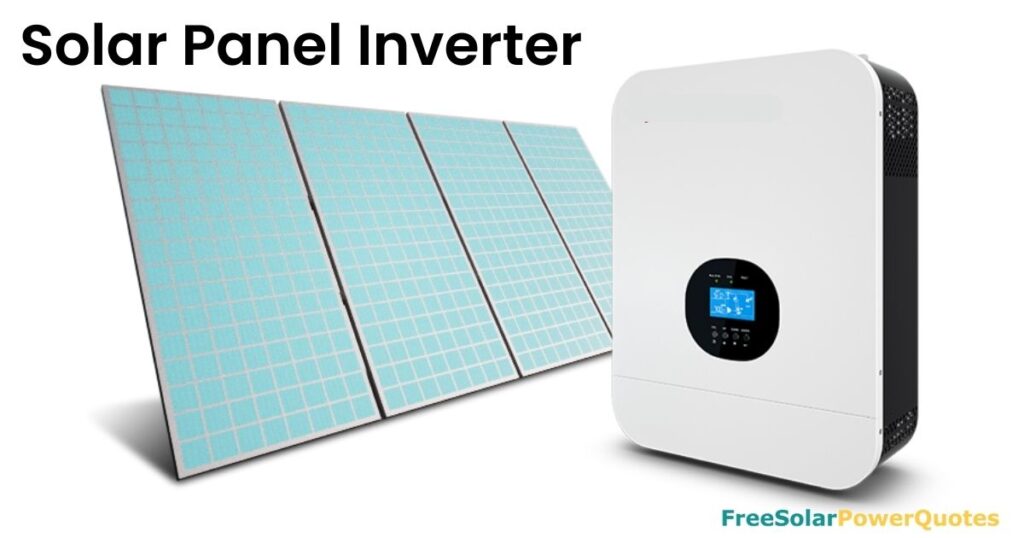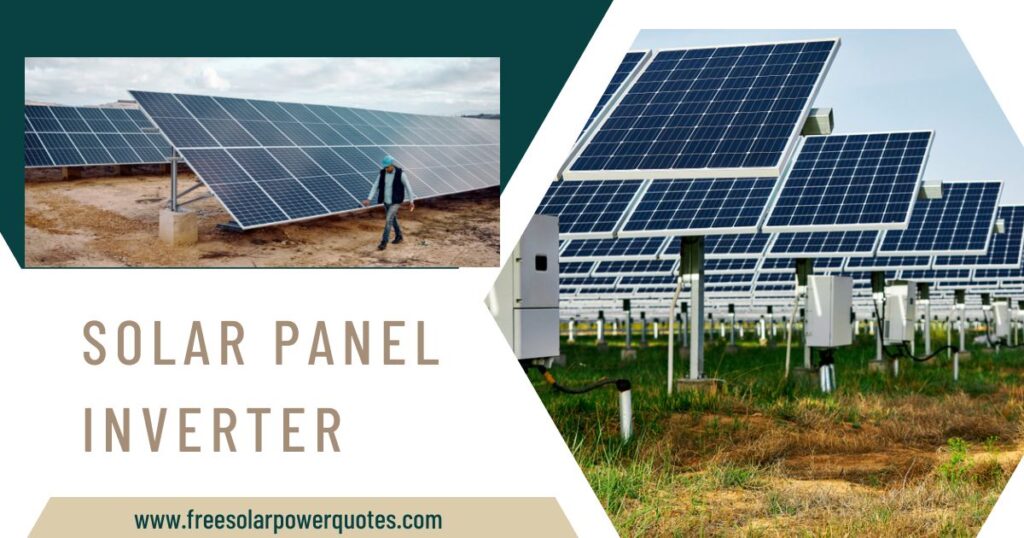The solar panel inverter is a critical component in a solar energy system. It takes the DC power produced by solar panels and changes it into the standard AC in homes and businesses. The inverter provides the building’s lighting, appliances, and electronics with alternating current electricity. This article will discuss the many types of solar panel inverters, their functions, and their advantages in a solar energy system.
What is a Solar Panel Inverter?
A solar panel inverter is an electronic device that converts the DC electricity generated by solar panels into AC electricity. It is a key component in a solar energy system, as it allows the electricity generated by the solar panels to be used in the building. The inverter is usually located near the solar panels and is connected to the panels by electrical cables.
Types of Solar Panel Inverters
String inverters, microinverters, and central inverters are the three most common types of solar panel inverters.
String Inverters
Most solar panels use a string inverter, which is the most popular type of inverter. They are called “string inverters” because they are connected to several solar panels in a string, usually through a single electrical cable. String inverters convert the DC electricity generated by the entire string of solar panels into AC electricity.
Microinverters
Microinverters, as the name suggests, are small inverters attached to each solar panel. They convert the DC electricity generated by each panel into AC electricity. The benefit of microinverters is that they allow each panel to operate independently, which can increase the system’s efficiency and reduce the impact of shading on the system’s performance.
Central Inverters
Central inverters are large, centralized inverters that are used in commercial and utility-scale solar energy systems. They are similar to string inverters in converting the DC electricity generated by multiple solar panels into AC electricity. Central inverters are typically used in large solar energy systems due to their high power output and efficiency.
How Does a Solar Panel Inverter Work?
The basic principle behind a solar panel inverter’s operation is converting DC electricity into AC electricity. The solar panels generate DC electricity when they are exposed to sunlight. This DC electricity is then fed into the inverter, which converts it into AC electricity that can be used in the building.
The inverter uses a process called pulse width modulation (PWM) to convert the DC electricity into AC electricity. In PWM, the inverter switches the DC electricity on and off very quickly, creating a series of pulses. The frequency of these pulses determines the frequency of the generated AC electricity. The inverter controls the frequency of the pulses to ensure that the AC electricity generated is within the required range for use in the building.

Benefits of Solar Panel Inverters
Increased Efficiency
Increased productivity is one of the key advantages of employing a solar panel inverter. The inverter is designed to optimize the output of the solar panels, which can result in higher electricity output. This can be especially important in systems with shading or other issues that can reduce the output of solar panels.
Improved Safety
Another benefit of using a solar panel inverter is improved safety. The inverter is designed to meet safety standards and is certified for use in solar energy systems. This means that the inverter is less likely to cause electrical hazards, such as short circuits or fires. The inverter also provides protective measures, such as surge protection and over-temperature protection, which help to ensure the safety and reliability of the system.
Easy Monitoring and Maintenance
Solar panel inverters often come with monitoring and maintenance features that make it easy to track the system’s performance. For example, many inverters come with built-in monitoring systems that allow you to track the performance of solar panels and inverters in real-time. This can be especially helpful for identifying and fixing issues quickly, which can help prolong the system’s life.
Grid-Tie Compatibility
Another benefit of solar panel inverters is their compatibility with the grid. Most solar panel inverters are designed to be grid-tie compatible, which means that they can connect to the electrical grid and feed excess electricity back into it. This can result in reduced electricity costs for the homeowner, as well as the ability to generate income from selling excess electricity back to the grid.
Bottom Line
In conclusion, the solar panel inverter is a critical component in a solar energy system. It takes the direct (DC) electricity produced by solar panels and changes it to alternating (AC) electricity. String inverters, microinverters, and central inverters are the three most common types of solar panel inverters. The inverter uses pulse width modulation to convert the DC electricity into AC electricity. The solar panel inverter’s benefits include increased efficiency, improved safety, easy monitoring and maintenance, and grid-tie compatibility. Overall, the solar panel inverter plays a vital role in making solar energy systems reliable and efficient and is an essential component for anyone looking to harness the sun’s power.
Ready to switch to solar power? Don’t wait any longer! Contact us today at freesolarpowerquotes.com to get your free, customized solar power quote.
FAQS
How many solar panels be connected to a battery bank, charge controller, or inverter?
These processes connect solar panels to a battery bank, charge controller, and inverter:
- Cable the solar panels to the charge controller.
- Cable the charge controller to the battery bank.
- Cable the charge controller to the inverter.
- Finally, cables connect the inverter to the electrical load (lights, appliances).
How to install solar panels with micro inverters?
To install solar panels with micro inverters, you need to follow these steps:
- Choose a suitable location for the solar panels, ensuring that they will receive adequate sunlight.
- Mount the microinverters to the back of each solar panel using the mounting brackets provided.
- Connect the microinverters to the solar panels using electrical cables.
- Connect the microinverters to the electrical load (e.g., lights, appliances) using electrical cables.
What is a solar panel inverter?
Solar panel inverters transform DC electricity from solar panels into AC electricity for homes and businesses.
How do you calculate the battery and inverter size for solar panels?
To calculate the size of a solar panel battery and inverter, you need to consider the following factors:
- The total daily energy consumption of the electrical load.
- The average daily sunlight hours at the location where the solar panels will be installed.
The efficiency of the solar panels, charge controller, and inverter.
- Based on these factors, you can use a solar panel sizing calculator to determine the size of the battery bank and inverter required for your system.
How to install solar panels and inverters?
To install solar panels and an inverter, you need to follow these steps:
- Choose a suitable location for the solar panels, ensuring that they will receive adequate sunlight.
- Mount the solar panels to the roof or ground using mounting brackets.
- Connect the solar panels to the inverter using electrical cables.
- Connect the inverter to the electrical load (e.g., lights, appliances) using electrical cables.
- Finally, connect the inverter to the electrical grid (if desired) using electrical cables.
What is a solar panel kit with a battery and inverter?
A solar panel kit with battery and inverter is a complete, pre-packaged system that includes everything needed to generate and store solar energy for use in homes or businesses. The kit typically includes solar panels, a battery bank, an inverter, a charge controller, mounting brackets, and all necessary electrical cables and hardware.
What are the benefits of a solar panel kit with a battery and inverter?
The benefits of a solar panel kit with battery and inverter include:
- Convenience: The kit provides everything needed to set up a solar energy system, reducing the time and effort required to gather components and hardware.
- Cost-effective: Solar panel kits with battery and inverter can be more cost-effective than purchasing components separately.
- Easy installation: The kit provides all the necessary components and instructions for a streamlined installation process.
- Reliability: The included components have been tested and optimized to work together, ensuring reliable performance.
- Independence: With the battery bank included, the system can store excess energy for use during periods of low sunlight or power outages.

